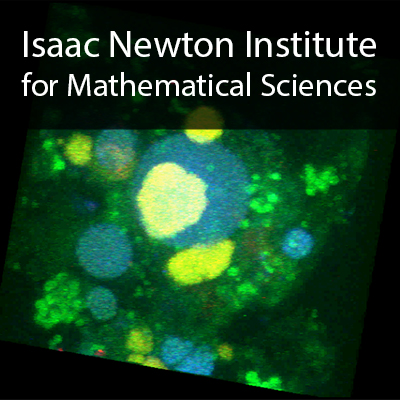Contributed Talk 2: Long distance relationships between algae and bacteria
Duration: 21 mins 11 secs
Share this media item:
Embed this media item:
Embed this media item:
About this item

| Description: |
Croze, O (University of Cambridge)
Thursday 27 November 2014, 10:40-10:55 |
|---|
| Created: | 2014-12-02 11:30 |
|---|---|
| Collection: | Understanding Microbial Communities; Function, Structure and Dynamics |
| Publisher: | Isaac Newton Institute |
| Copyright: | Croze, O |
| Language: | eng (English) |
| Distribution: |
World
|
| Explicit content: | No |
| Aspect Ratio: | 16:9 |
| Screencast: | No |
| Bumper: | UCS Default |
| Trailer: | UCS Default |
| Abstract: | Co-authors: F. Peaudecerf (Department of Applied Mathematics and Theoretical Physics (DAMTP), University of Cambridge), M. A. Bees (Department of Mathematics, University of York), R. E. Goldstein (Department of Applied Mathematics and Theoretical Physics (DAMTP), University of Cambridge), A. G. Smith (Department of Plant Sciences, University of Cambridge)
Microbial interactions are often predicated on metabolism: e.g. auxotrophs depend on nutrients made by other microbes. Many algae are vitamin auxotrophs, with several known species requiring exogenous vitamin B12 [1]. This vitamin must be obtained from bacteria, as only they can synthesise it. Laboratory experiments have demonstrated mutualistic interactions between bacteria and B12-dependent algae. Populations of the bacterium Mesorhizobium loti (B12 producer, carbon requirer) and the green alga Lobomonas rostrata (B12 requirer, carbon producer) in co-culture stabilise to an algae/bacteria ratio of 1/30, independent of initial inoculum ratio [2]. system [3]. Here we consider the interactions between microbial populations separated in space. Experiments on hard agarose indicate that mutualistic interactions exist at a distance. We present a mathematical model capturing the essence of these experiments: growing populations of algae and bacteria coupled by a diffusive channel. Solutions to the model reveal rich dynamics. We will discuss these and speculate on the ecological significance of our findings for understanding environmental biofilms and microbial mats. [1] Croft, M. T. et al. Nature 483:90–93 (2005) [2] Kazamia, E. et al. Environ. Microbiol. 14, 1466 (2012) |
|---|---|
Available Formats
| Format | Quality | Bitrate | Size | |||
|---|---|---|---|---|---|---|
| MPEG-4 Video | 640x360 | 1.94 Mbits/sec | 308.80 MB | View | Download | |
| WebM | 640x360 | 594.57 kbits/sec | 92.32 MB | View | Download | |
| iPod Video | 480x270 | 522.35 kbits/sec | 81.04 MB | View | Download | |
| MP3 | 44100 Hz | 249.85 kbits/sec | 38.80 MB | Listen | Download | |
| Auto * | (Allows browser to choose a format it supports) | |||||

